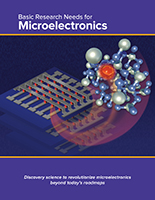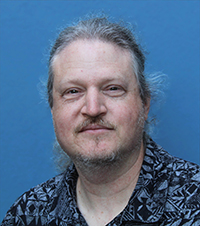
By Lori Tamura
On August 16, Berkeley Lab hosted a town hall on future research and collaboration opportunities in microelectronics—a deceptively simple catchword that encompasses the materials, chemistries, devices, systems, architectures, algorithms, and software needed to push digital computing beyond Moore’s Law.
For over 60 years, advances in electronic miniaturization have followed a steady path, predicted (and guided) by Moore’s Law. Now, however, there is strong evidence that this downscaling is reaching physical limits, even as advances in areas such as machine learning, artificial intelligence, and the internet of things demand increasing computing power.

In light of this, the Department of Energy’s Office of Science is considering the launch of a multiprogram basic research initiative in support of microelectronics and has already held a Microelectronics Basic Research Needs (BRN) workshop in October 2018. The broad goal of the Lab’s town hall this month, which included representatives from across Lab divisions—including the ALS—was to create a microelectronics “innovation ecosystem” that can be very agile in response to these developments. It builds on a Lab initiative announced last July, dubbed “Beyond Moore’s Law,” led by Ramamoorthy Ramesh (of the Lab’s Materials Sciences Division and UC Berkeley) and Dan Armbrust (a Lab affiliate and former president the Sematech consortium of semiconductor companies).

Eli Rotenberg (chair of the ALS Science Council and program development lead) was invited to give one of several five-minute “lightning talks” at the gathering. In his presentation, Rotenberg described how the ALS fits into the microelectronics ecosystem at the Lab. The ALS has a clear record of successful studies on phenomena that could be exploited for new electronics: oxides, topological materials, materials with novel charge and spin textures, two-dimensional materials—all are very hot topics right now. In terms of experiment types, Rotenberg noted investigations into buried interfaces, fluctuations, confined states, and operando conditions.
A key point was that the parallel-development (“co-design”) approach called for in this effort can be applied at the ALS with existing tools. With more resources, Rotenberg said, a lot more could be done, such as integrating synthesis and characterization tools, incorporating machine learning and modeling, and enabling high-throughput measurements that look at many material families at once, with multiple tools. Looking further into the future, Rotenberg gave examples of larger-scale projects ranging from expanding experimental floor space to the redevelopment of “old town”—a cluster of early laboratory buildings near the ALS, which includes Building 7.
In closing, Ramesh emphasized that co-design was a core theme coming out of the BRN workshop and will be key to a successful effort. On the materials physics side, he declared that all ideas are on the table: the “aperture is wide open.” Through subsequent biweekly meetings, the group plans to identify themes and build up a core set of teams to shepherd the process forward.